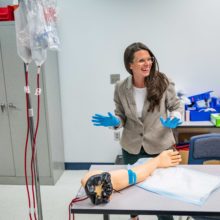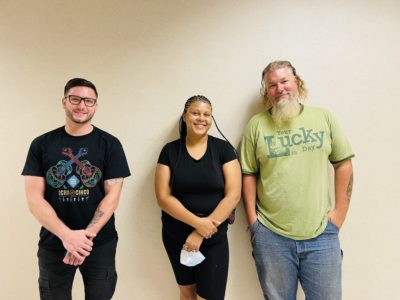
Share this story
- Low retention rates are affecting all of higher education. North Carolina community colleges are dialing in to address student retention, and we unpack how they're doing so.
- Community colleges across the country enroll some of the most diverse student populations. In N.C., colleges are working to provide holistic services to students.
|
|
Over 40% of fall 2020 community college first-year students did not return to college their second year, according to data from the National Student Clearinghouse Research Center (NSCRC).
It’s a widespread phenomenon affecting all of higher education in the U.S., and the pandemic has only made it worse. The percentage of students who returned for a second year to the institution where they initially started (known as the retention rate) fell during the pandemic. Public community colleges experienced a notable decline in retention rates from fall 2019 to fall 2020. And while retention rates have increased in fall 2021, they have not returned to pre-pandemic levels.
Community colleges – in North Carolina and beyond – enroll some of the most diverse student populations.
“They are 16 years old and they’re 73 years old and they’re everything in between,” said Dr. Janet Spriggs, president of Forsyth Technical Community College. “They are working parents, single mothers, and they’re facing all kinds of life circumstances that most people don’t recognize.”
The North Carolina Community College System (NCCCS) was founded in the early 1960s to provide accessible postsecondary education to any student regardless of prior educational experience.
And that’s what the state’s community colleges have done – offering opportunities leading to everything from a high school diploma to short-term workforce credentials to university transfer degrees. In the 2020-2021 academic year, the NCCCS served over 500,000 students.
But many of these students – some of them low income, first-generation college-goers, or adult learners – experience financial, transportation, and child care challenges that can make academic success more difficult. These challenges lead students to drop out or stop out – a phrase commonly used to describe those who need to put their education on pause for certain periods of time.
Students dropping or stopping out has ramifications for both the students and the colleges.
Postsecondary attainment is a pathway to economic opportunity. The lifetime earnings of someone with a college education are greater than someone with only a high school education. Earning a credential helps move families economically but it is also linked to better physical and mental health, relationships, and civic engagement. In light of that, North Carolina community colleges are increasingly adding supports to help their students stay in college.
“Something we talk about often is are we trying to get more numbers, or are we trying to keep and graduate the numbers that we have?” said Heather Calihan, Coastal Carolina Community College’s director for admissions and counseling services. “What most of us are doing is not pushing students toward our goals but toward what’s going to help them.”
The challenges of retaining N.C. community college students
Often students are forced to drop out or cut back on classes because life happens – such events include homelessness, food insecurity, mental health crises, transportation issues, lack of child care options, problems with technology, and so on.
At Coastal Carolina Community College, for example, many students stopped attending after losing housing or a job following Hurricane Florence in 2018. More recently, students are opting to take fewer classes to work more hours to offset the high cost of living, said Isothermal Community College (ICC) President Dr. Margaret Annunziata.
Since many community college students are part-time, dropping even one class could impact their enrollment status. And for adult students who stop taking classes, a pause in their education often becomes a full stop, Annunziata said.
In fall 2019, nearly 50% of NCCCS students were 25 and older, according to system headcount data. These students, referred to as adult learners, are more likely to have child care challenges and increased financial responsibilities.
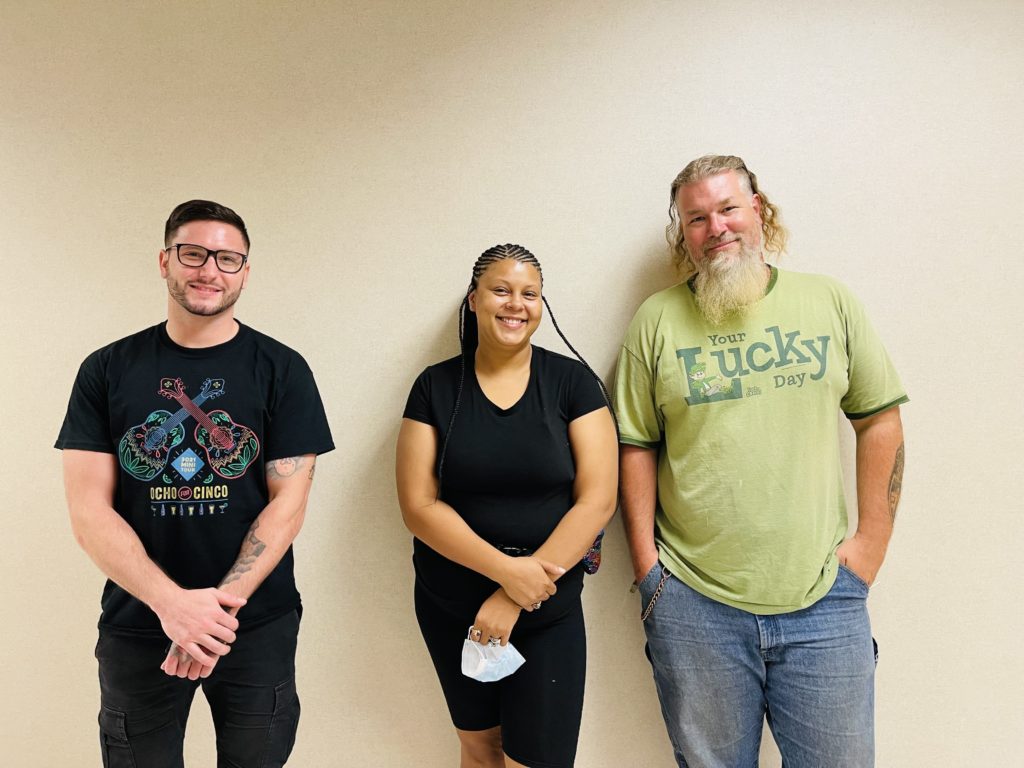
Community college students often face food and housing insecurity. Thirty-nine percent of students at two-year institutions report food insecurity compared to 29% at four-year colleges, The Hope Center’s 2021 college report found. About 48% reported housing insecurity. Transportation is also an issue for students, especially with high gas prices.
At rural campuses, students are more likely to struggle to access reliable broadband in addition to transportation, Annunziata said.
Students of color, veterans, disabled, and LGBTQ+ students also face unique challenges.
Nearly 5% of students at public community colleges are veterans, according to a 2019 report from the American Association of Community Colleges. Student veterans experience challenges navigating financial aid, veteran education benefits, disability services, and transitioning to a less organized style of learning, said Central Carolina’s Jennifer Servi-Roberts.
“Just being in a class where you don’t feel like anybody really shares the same life experiences that you do is challenging as well,” she said.
Black, Brown, and LGBTQ+ students might similarly feel underrepresented at their college. They are also more likely to face financial barriers that could make staying in school difficult. Black men suffered the largest enrollment decline in the NCCCS in fall 2020 – with traditional degree-seeking enrollment falling 14% from the year prior. That’s compared to an overall 11% decline in enrollment.
Mental health challenges can compound all the above barriers. Nearly 44% of college students report symptoms of depression/anxiety, according to a 2021 report by the Mayo Clinic Health System. Suicide is their third leading cause of death.
Colleges increasingly have financial and mental health supports available, but students don’t always know about the resources. Some feel uncomfortable reaching out about them. Among students facing basic needs insecurity, for example, Hope Center data shows 52% didn’t apply for supports because they didn’t know how.
In a student survey conducted by the State Board of Community Colleges last semester, 54% of the 3,000-plus students surveyed said changes to balance college with work or family commitments would make it easier for them to succeed.
Another 39% said changes to tuition and fees would help them. And 17% said increased advising and support would help them succeed as students.
These survey results – from students at 49 of 58 North Carolina community colleges — highlight just how many factors community colleges must consider when working to retain students.
Why retention matters
Nationwide, postsecondary enrollment fell to 16.2 million in spring 2022. According to NSCRC data, community colleges have lost over 827,000 students since the start of the pandemic. While some N.C. community colleges experienced gains last fall, enrollment challenges continue across the system.
Those challenges are due, in part, to declining populations in the state. As populations shift, so do community college enrollments. That’s been true at 46 of the 58 community colleges. North Carolina community colleges are largely funded based on their enrollment.
With declining populations, retention efforts are even more imperative.
So what is the secret sauce to retaining students at North Carolina community colleges? It’s more than just good teachers and sharing knowledge with students, Spriggs said. It’s finding ways to understand who students are and recognizing that you must help the whole person in their journey. Successful retention is meeting their academic needs and mitigating life event barriers.
Here’s a look at how North Carolina community colleges are dialing in on student retention.
Putting systems, processes, and people in place
Community college leaders say retention starts with intentionality and relationship building.
A system that alerts faculty and staff to students who may be falling behind is a good first step. For 41 of the state’s 58 community colleges, that system is Watermark Student Success & Engagement (formerly Aviso), a software that identifies students who are at risk. Employees can use the software to send early-alert warnings about students missing assignments or experiencing other life circumstances. Those early alerts prompt a follow-up from the appropriate department at the college.
Changing course delivery is another way to reduce stop outs. Colleges recently started offering hy-flex courses. Hybrid flexible instruction joins traditional, online, hybrid, and blended instruction, allowing students to choose how to participate and when. Some institutions are taking college on the road, providing courses in a variety of locations throughout their service areas.
Blue Ridge Community College president, Dr. Laura Leatherwood, said the college started amending processes and policies that impede students’ ability to stay enrolled. For years, Blue Ridge had a policy that allowed students who requested an incomplete only one semester of extension. Leaders said letting the calendar dictate if students received course credit seemed rigid, so the college changed its policy.
But changing systems and processes can only do so much.
At the end of the day, the people on campus often have the greatest impact on a student’s success.
Marbeth Holmes, Nash Community College‘s dean of student wellness, previously said building relationships with students is crucial. Without relationships, even the best resources won’t work, she said.
“We work very hard to build trust,” Holmes said. “If they trust us, they will utilize our services. If they utilize our services, their work and their stability and their wellness will improve — so that’s fundamental.”
To bridge the gaps between the classroom and student services, many community colleges are implementing success coaches on their campuses. Success coaches are typically a student’s singular point of contact and help them navigate campus resources and services.
Success coaches at Stanly Community College are part of a larger team including a faculty member and a licensed counselor. The success coaches are required to make contact with their students at least three times per semester, and one of those must be a synchronous conversation, said Stanly president, Dr. John Enamait.
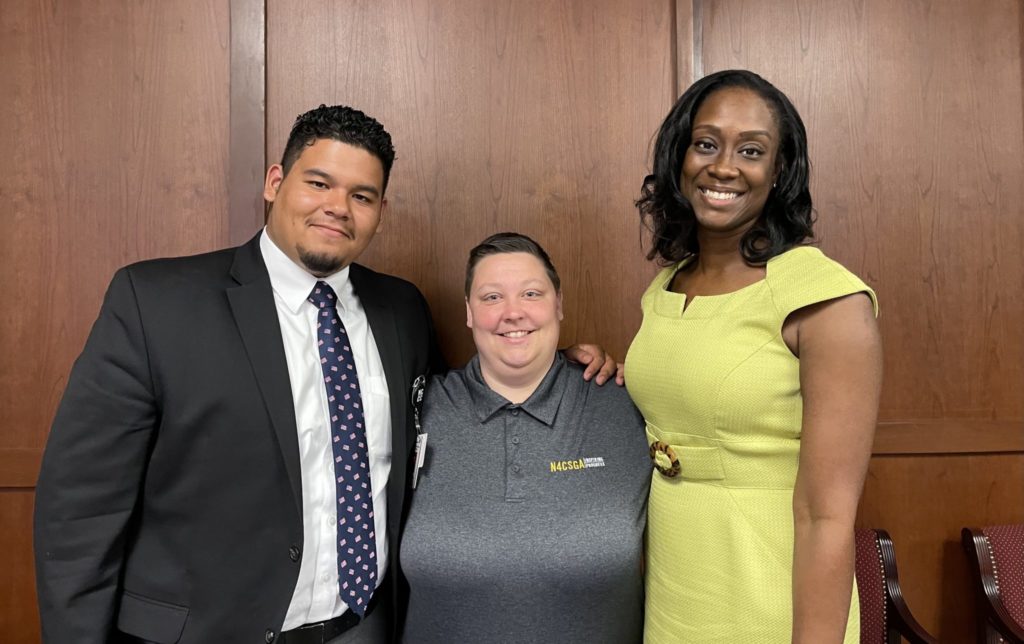
During the State Board student survey process, many students from special populations said mentors or counselors would help them be successful, the N.C. Comprehensive Community College Student Government Association (N4CSGA) leadership team said.
“With the changing landscape of America and having to overcome the barriers of COVID, we feel this isn’t a problem that will go away if we don’t address students’ needs,” N4CSGA 2021-23 leaders said.
Connecting students to resources
Pitt Community College created an intake form to assess students and connect them to support services. The form is a series of questions about college terminology, academic goals, course delivery preference, and employment status. It also asks students to identify areas in which they may need assistance or additional support. Such areas include academics, finances, career planning, food assistance, child care, technology access, and transportation.
Titan Link at Guilford Tech Community College offers many resources: a food bank, financial literacy, transportation, housing assistance, and more.
Similarly, Forsyth Tech Cares supports students and employees struggling with food insecurity by providing a food pantry and farmer’s market. The farmer’s market is open to the public and offers free fresh produce twice a month from April to October.
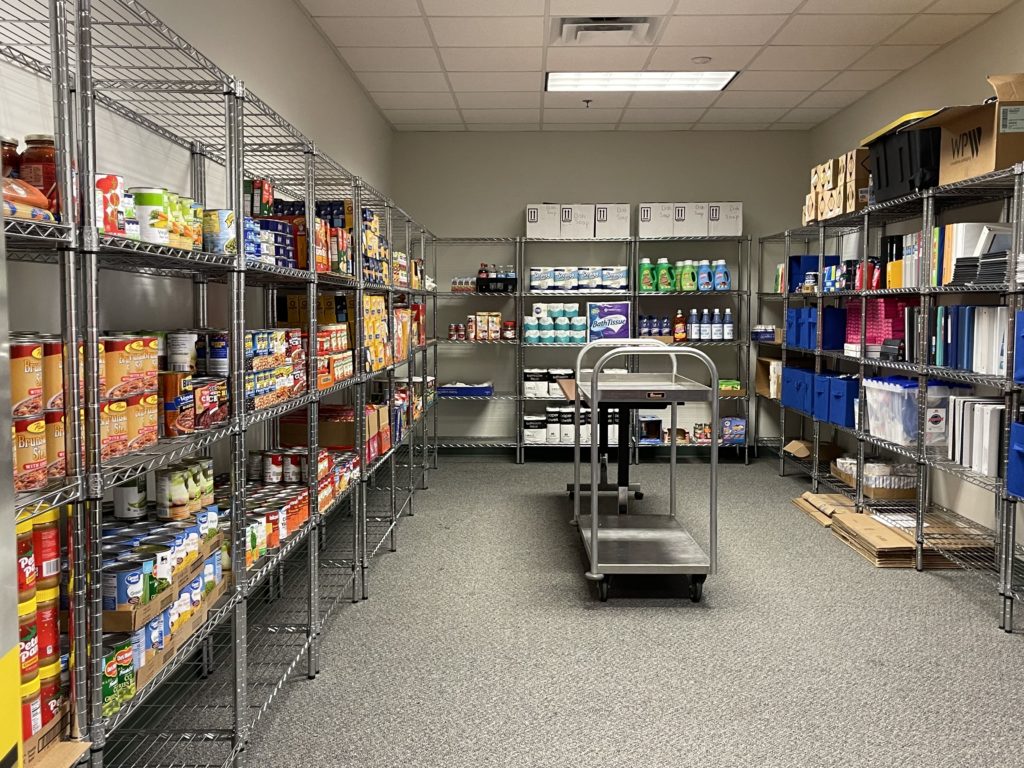
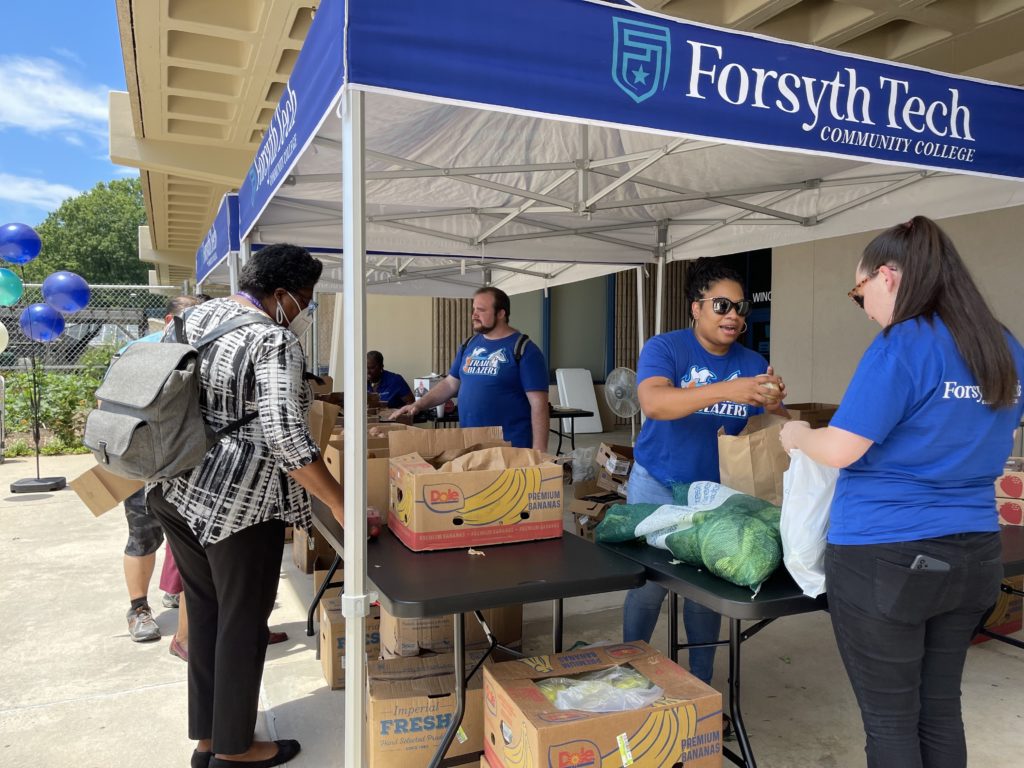
Forsyth Tech students who received assistance during fall 2020 and spring 2021 were 5% more likely to complete their courses compared to students who did not receive assistance, according to the college.
“We know that advocating for non-academic resources are equally as important to making sure a student is successful in their path to graduation,” the N4CSGA team said.
Some colleges are providing students with gas cards and bus passes. In some instances, colleges have used funds to repair cars for students.
This summer, ICC provided a shuttle service for a small group of students participating in Summer Bridge. That six-week program is designed to support first-year students prior to beginning the fall semester. There is not currently a solution for students needing transportation services throughout the year.
To mitigate child care challenges, many community colleges offer vouchers to help pay for child care assistance. In the biennium budget passed in November 2021, non-recurring funds were allocated to the Child Care Grant program that helps community college students with child care expenses. Some N.C. community colleges also offer child care onsite.
Equipping community college employees
Stanly’s Dr. Enamait believes student retention also rests with advancing faculty and staff knowledge. The college requires 30 hours of professional development each year, eight of which must be related to diversity, equity, and inclusion training.
“That’s all in an effort to make sure that we’re creating a welcoming environment for all of our students,” said Enamait.
N.C. community colleges around the state are increasingly offering Safe Zone and Green Zone trainings to help employees better serve LGBTQ+ and veteran students.
Enamait started a President’s Leadership Academy with the help of the Belk Center for Community College Leadership and Research. It’s an internal leadership program that requires participants to work on projects, one of which is to identify a student success gap within the college, find the data to support the gap, and then propose a solution.
One project team found that retention was an issue in Stanly’s health sciences programs. The project team discovered problems stemmed from students not being able to access appropriate tutoring. While Stanly had generic tutoring on campus, it did not offer program-specific tutoring. And for allied health students, the study skills needed are different from other programs. To remedy the problem, Stanly plans to hire a learning resource specialist specifically for allied health.
Given the large number of rural-serving community colleges in North Carolina (40 out of 58) the Belk Center, in partnership with Achieving the Dream, launched a Rural College Leaders Program (RCLP) earlier this year. The program helps rural-serving institutions address the challenges they face and capitalize on opportunities. RCLP is a three-year program supported by Ascendium Education Group and is designed to close equity gaps and improve student outcomes. Ten community colleges are part of the program. College leaders will “collaborate to define measurable goals, leverage evidence-based practices, identify opportunities, and develop action plans addressing strategic priorities.”
As for addressing students’ mental health?
State-wide initiatives are underway to help community college personnel support students experiencing mental health challenges. One of those is Mental Health First Aid (MHFA), an international skills-based training to help participants identify, understand, and respond to mental health and substance use issues.
“In today’s world, I believe that mental health first aid should be just as common as general first aid or CPR,” said Dr. Rachel Desmarais, president of Vance-Granville Community College.
Every North Carolina community college recently had the option to train at least one employee on their campus. There are currently 135 trained MHFA instructors across the NCCCS. Trained instructors can then provide training on their campus. They can also offer the course through their college’s continuing education program to train other agencies and community members.
What’s next for strengthing student retention?
“It all comes down to having enough resources so that we can do what we need to do,” said Enamait.
Those resources include investing in the people already working on community college campuses and having the funds to hire additional faculty and staff.
Stanly, for example, has 11 success coaches, but Enamait said student case loads are much higher than he would like. He needs more coaches, but he can’t afford to hire them.
Enamait isn’t alone in that need. The N4CSGA leadership team said they want more coaches funded across the state for deeper student check-ins throughout the semester. In spring 2022, the NCCCS released legislative priorities that included more funding to retain and attract talented employees.
At Wake Technical Community College — the largest campus in the system with 55,000-plus students — president Dr. Scott Ralls said you can’t separate enrollment and funding from retention.
“If you’re interested, as we have been in the community colleges for years, in student success, student success comes through completion. And retention is about completion,” Ralls said. “So the enrollment battle — much more of it is about how you retain students than it is about just recruiting new students. You can’t get to your completion goals without retention, and you can’t get to your enrollment goals without retention either.”


